 All of our kitchen door materials are shown below and how each the kitchen doors are constructed. We hope you find this information useful when deciding upon your new kitchen.
All of our kitchen door materials are shown below and how each the kitchen doors are constructed. We hope you find this information useful when deciding upon your new kitchen.
Download our useful kitchen doors materials PDF here
Door Materials
- Timber
- Melamine
- Veneer
- Vinyl Faced MDF
- Painted/Lacquered MDF
- Painted Vinyl MDF
- Painted Timber
- Acrylic Faced MDF
Timber 
Our timber is selected only from premium grade trees sourced from environmentally regulated and renewable forests.
Using traditional mortice and tenoning techniques, doors are carefully assembled in our workshops before being sanded and finished with several layers of high quality lacquer. Special care is taken to ensure that a uniform finish is achieved and a highly durable surface created.
Melamine MFC 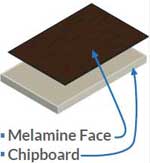
Melamine faced chipboard, (MFC) is manufactured from resin coated particles of softwood. These particles are evenly spread over a flat plate bonded together under high pressure.
The melamine face is effectively the decorative finish that is seen on the external sides of the board and is available in numerous colours and wood grains.
Various textures can be applied to the melamine during the manufacturing process to create gloss and matt finishes and even heavily embossed wood grain effects
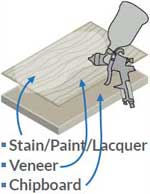 Veneer
Veneer
A veneer is a thin slice of timber taken from a log which is then bonded to a chipboard or MDF (medium density fibreboard) substrate and sealed with either a stain and/or lacquer.
The advantage of using veneers over solid timber is the ability to maintain the consistency of the grain pattern and colour.
Vinyl Faced MDF (Foil Wrapped)
 A thin layer of plastic (vinyl) or paper mixed with resin (foil) is wrapped and bonded to a MDF (medium density fibreboard) substrate.
A thin layer of plastic (vinyl) or paper mixed with resin (foil) is wrapped and bonded to a MDF (medium density fibreboard) substrate.
Vinyl and foil is one of the more widely used materials in the manufacture of kitchen doors.
The versatility of this type of material means that it can be printed with a wood grain effect to create the look of a natural timber door. Single colour vinyls and foils (uni-colour) are particularly useful for replicating the look of a matt painted surface and high gloss finishes.
Painted/Lacquered MDF
 Several coats of high quality paint or lacquer are applied directly to a MDF (medium density fibreboard) substrate.
Several coats of high quality paint or lacquer are applied directly to a MDF (medium density fibreboard) substrate.
The first process requires the doors to be primed, they are then placed in an oven to cure and once cured, are de-nibbed (finely sanded). The top coat is then applied and the doors are then returned to the oven for further curing to create a highly durable and resilient surface.
Painted Vinyl MDF
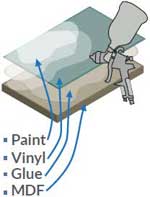 Several coats of high quality paint are applied to the surface of a vinyl faced mdf (medium density fibreboard) substrate.
Several coats of high quality paint are applied to the surface of a vinyl faced mdf (medium density fibreboard) substrate.
The first process requires the doors to be primed, they are then placed in an oven to cure and once cured, are de-nibbed (finely sanded).
The top coat is then applied and the doors are then returned to the oven for further curing to create a highly durable and resilient surface.
Painted Timber
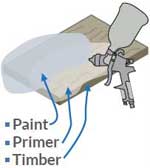 Several coats of high quality paint are applied to the surface of a timber (generally oak) substrate.
Several coats of high quality paint are applied to the surface of a timber (generally oak) substrate.
The first process requires the doors to be primed, they are then placed in an oven to cure and once cured, are de-nibbed (finely sanded). The top coat is then applied and the doors are then returned to the oven for further curing to create a highly durable and resilient surface.
Acrylic Faced MDF
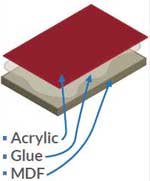 A thin layer of high gloss acrylic is bonded onto a MDF (medium density fibreboard) substrate.
A thin layer of high gloss acrylic is bonded onto a MDF (medium density fibreboard) substrate.
The finish of acrylic imitates glass but is much more cost effective.
Download our mobile app
Looking for some kitchen inspiration? Take a look at some of our real customer kitchens, video reviews as well as advice in our mobile app. We’ll also keep you up to date with any new ranges and offers that we have available.
Up to 50% off competitor kitchen prices
At DIY Kitchens, not only do you get a quality rigid built kitchen but you also get it at a fabulous price too! Price your kitchen up on our site and you could see savings of up to 50% off other kitchen quotes that you’ve had.
Take a look at our kitchen price comparison page here.
Real customer kitchens
Get some inspiration for designing your own new kitchen with over 3,000 pictures of our customers’ kitchens that they ordered from us.
Hi, we need to decide between the Clayton Painted or Stanbury Painted range – the latter is lacquered and are wondering what the benefits are of lacquer over paint in terms of durability and sheen. Thank you.
Hi Srta, Clayton and Stanbury are both MDF matt painted & lacqured. They are both as durable as each other but the Stanbury door is 19mm thick where as the Clayton door is 22mm thick with V-groove detailing.
Hi
I am in the process of purchasing a carrera kitchen with top boxes however there is no enough height for the 120mm gap. Can the top box doors be trimmed down to size and how might one finish it?
Thanks
Jane
Hi Jane, we have top boxes in 3 different heights here. It’s not possible to cut doors/units down any smaller than 290mm high top box.
I have a sample of the Clayton door in Knightsbridge blue but I can’t find it on the website for planning.
Hi, only Cobham Blue is available in Clayton.
Hi,
I am looking at replacing my kitchen and my builder has pointed me towards Howdens however I came across your site and much more prefer the kitchens you do.
My only issue is that the corner units are different to those they do, which I prefer – would you be able to amend your units so that the corner is a 90 degree join and the doors are hang so that they meet in the middle? I understand that there may be a cost involved to achieve this but would like to know if this is at all possible?
The kitchen I was looking at is the Broadoak Natural.
Many thanks,
Marieta
Hi, we do not have the type of corner unit that you are requesting. Our L Shaped corner units are supplied with a centre bifold hinge and no corner post. Sorry we could not help any further.
Hi I have been looking at the painted carrera kitchens and like the look and colors I am a bit concerned however as to whether the painted laquered mdf is as hard mearing as say a gloss kitchen. Is the process the painted doors goes through called a structured Laquer.
Also are these doors maintainable with things like scratches e.t.c.
We are looking to make a decision very soon and would appreciate you comments asap so we can choose and move forward Quickly
Thanks very much
Joanna Banks
Hi, the answer to your question is above.
Hi I have been looking at the painted carrera kitchens and like the look and colors I am a bit concerned however as to whether the painted laquered mdf is as hard mearing as say a gloss kitchen. Is the process the painted doors goes through called a structured Laquer.
Also are these doors maintainable with things like scratches e.t.c.
Thanks very much
Hi,
All the doors that we produce and supply are hardwearing and resilient. The process for making these doors is shown in the image above depicting the layers in the manufacturing process. Possibly the top most resilient doors would be ones that are “Acrylic Faced MDF”. Acrylic makes it very easy to buff away scratches.
Over time, all doors are prone to accidental damage from dropping knifes down them to rubbing past them with jeans and catching the doors with keys hanging out of your pocket. But, as long as you don’t have ravines in your doors then all doors that we sell should be easily maintainable.
We know that accidents do happen and nothing can really prevent them, so to help our customers, we do supply some door touch up paint inside the fittings box for scenarios such as this.
I hope this helps.